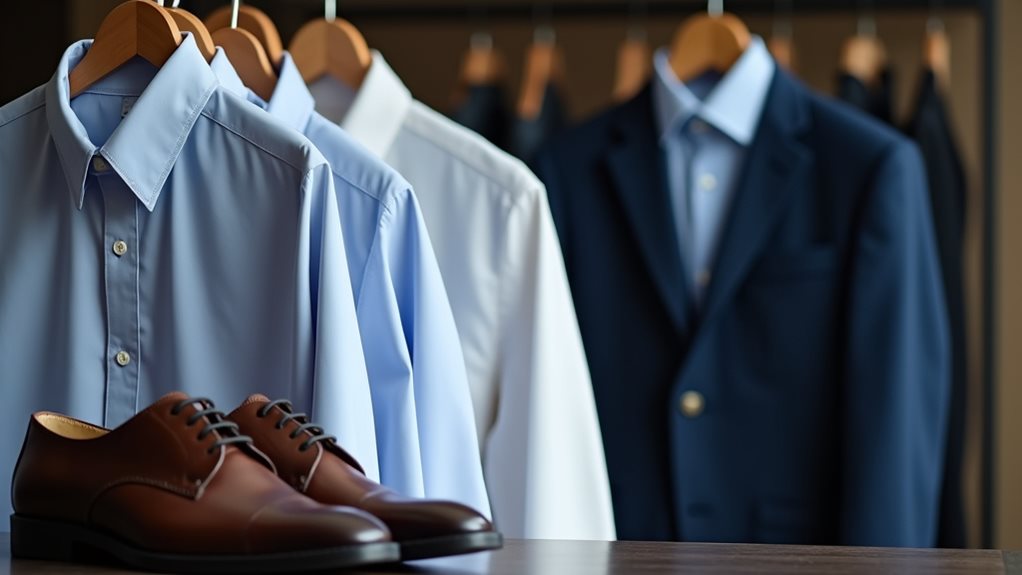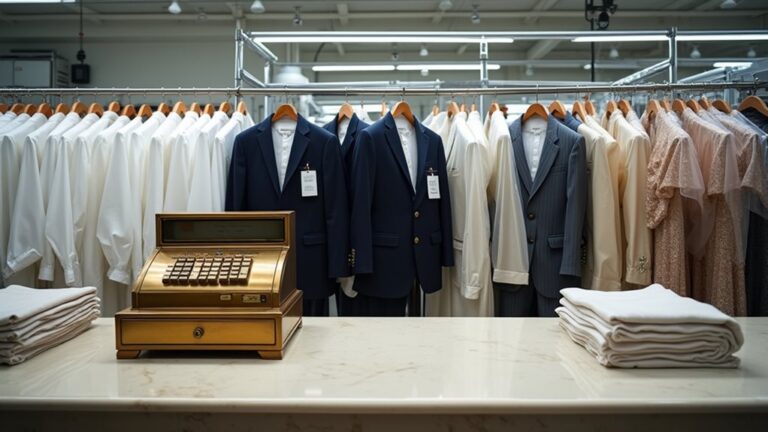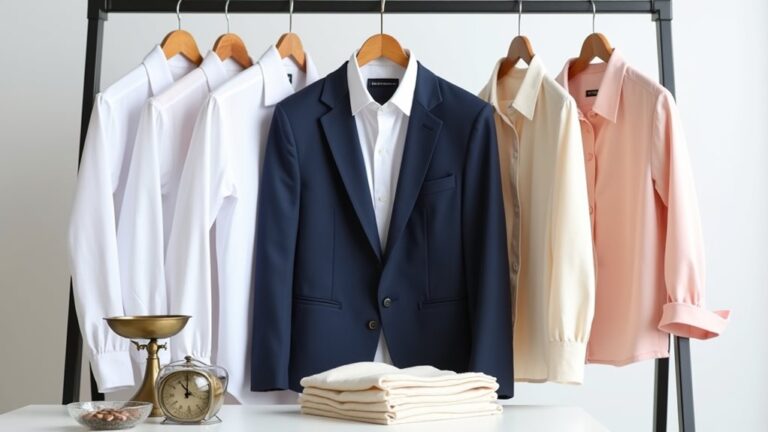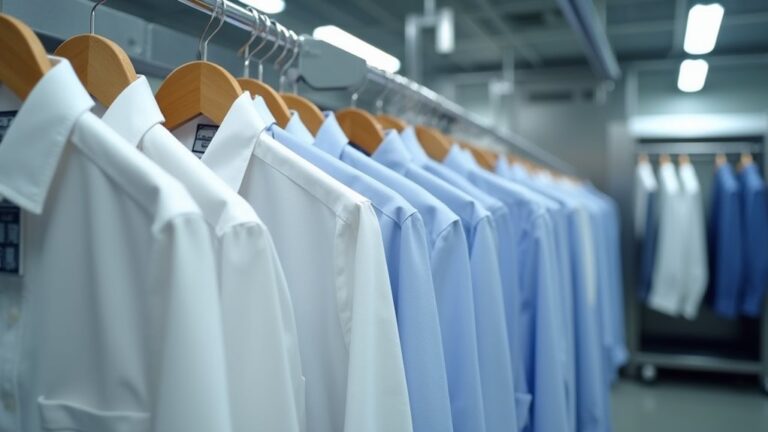You’ll spend PHP 100-150 for basic shirts and PHP 350-800 for business suits when dry cleaning in the Philippines, though I’ve learned the hard way that location matters tremendously—Metro Manila cleaners charge 30-50% more than provincial shops. Specialty items like wedding gowns can exceed PHP 1,000, while express services add another PHP 100-300 to your bill, and honestly, those “starting prices” rarely reflect what you’ll actually pay once stain removal and rush fees creep in, but there’s definitely more to this pricing puzzle.
Average Pricing for Common Garments
When I first moved to Manila and needed my interview suit cleaned, I honestly had no clue what I’d be paying – and let me tell you, sticker shock is real when you’re budgeting on a fresh graduate’s salary! 😅
If you’re wondering about dry cleaning costs here in the Philippines, you’ll find that a basic shirt typically runs between PHP 100 to PHP 150, which might seem steep compared to regular laundry, but trust me, there’s a reason your favorite button-down needs that special care.
Suits will set you back PHP 500 to PHP 800, while formal dresses range from PHP 300 to PHP 1,200 depending on embellishments.
Coats and jackets usually cost PHP 400 to PHP 700, though many shops offer bulk discounts that’ll help stretch your budget.
Keep in mind that fabric complexity can significantly impact your final bill, especially if you’re dealing with delicate materials or intricate designs that require extra attention.
Factors That Influence Dry Cleaning Rates
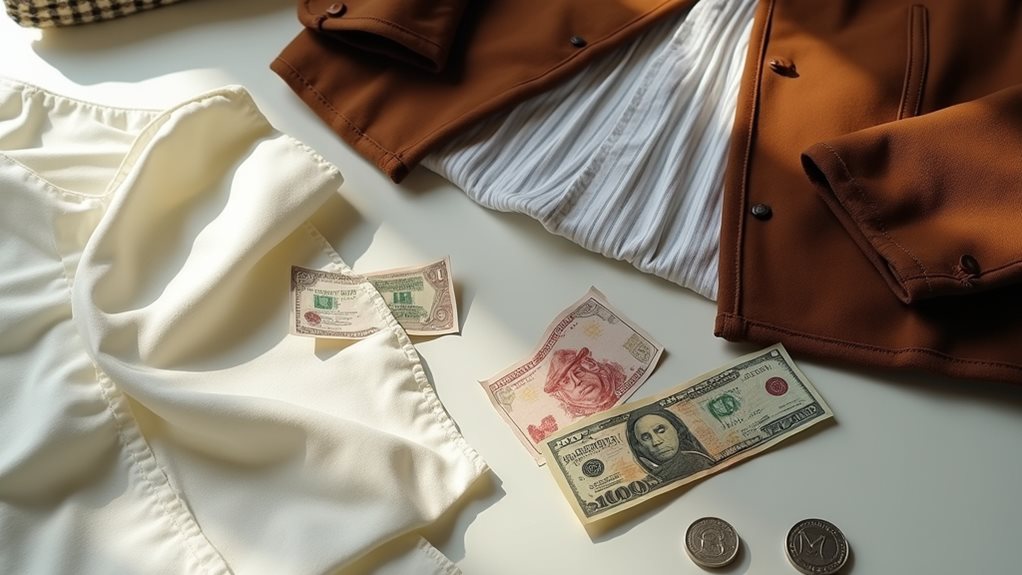
You’ve probably noticed that your silk blouse costs considerably more to clean than your cotton shirt, and honestly, that difference used to frustrate me until I learned why fabric type plays such a large role in pricing.
The location of your chosen dry cleaner also matters more than you might expect, especially since I’ve discovered that shops in Makati or BGC can charge double what you’d pay in smaller cities like Iloilo or Davao.
Understanding these two key factors—what you’re cleaning and where you’re getting it cleaned—will help you budget better and avoid those surprising moments when the bill doesn’t match your expectations.
Additional services like rush orders or complex stain removal treatments can significantly increase your final bill beyond the base cleaning price.
Garment Type Variations
Although I learned this lesson the hard way after bringing my favorite blazer to three different cleaners, the type of garment you’re having cleaned dramatically affects what you’ll pay, and understanding these variations can save you from both sticker shock and potential disappointment.
Your basic business suits will typically run PHP 350-800, while that gorgeous cocktail dress might only cost PHP 200-600 depending on its fabric considerations and detailing.
Here’s where proper garment care gets expensive: specialty items like wedding gowns or anything made from silk and chiffon can easily exceed PHP 1,000 because they require advanced cleaning techniques and extra handling.
Trust me, those delicate fabrics and intricate embellishments aren’t just charging you more for fun – they genuinely need specialized care that takes more time and expertise.
Additional services like stain removal or rush processing will also bump up your final bill, especially if your garment requires special treatment beyond standard dry cleaning procedures.
Service Location Impact
Location matters more than I initially realized when I first started exploring dry cleaning options around Metro Manila. The difference between what you’ll pay in Makati’s business district versus a neighborhood shop in Quezon City can be surprisingly dramatic.
Service location trends reveal that premium areas like BGC and Makati command higher rates due to expensive rent and affluent clientele expectations. Urban pricing dynamics show you’ll typically pay 30-50% more in these business districts compared to suburban areas.
Competition effects become apparent when you venture into neighborhoods with multiple laundromats – prices naturally drop when shops fight for customers. I’ve learned that walking just a few blocks away from prime commercial zones can save you considerable money without sacrificing quality.
This pattern mirrors international trends, where regional differences in major cities like London consistently result in higher dry cleaning rates compared to suburban locations.
Regional Price Variations Across Major Cities
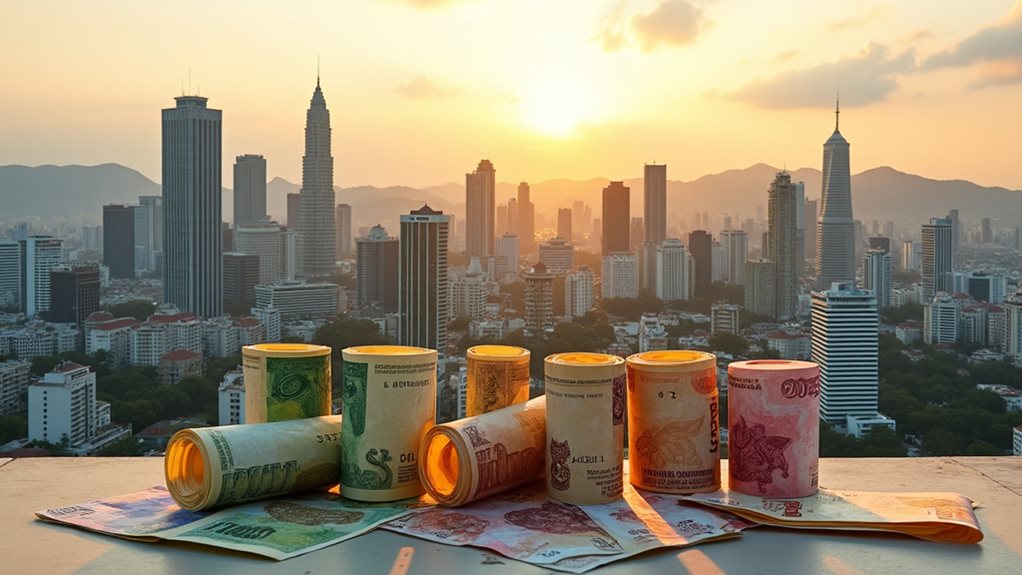
You’ll quickly discover that where you live in the Philippines dramatically affects your dry cleaning budget, much like how a fancy coffee costs twice as much in Bonifacio Global City compared to your neighborhood tindahan.
Metro Manila’s pricing standards typically set the bar highest, with those sleek Makati establishments charging around PHP 300 for your business suits, while you’ll find friendlier rates in provincial cities like Cebu and Davao that can save you 10-20% on each garment.
The urban versus rural cost divide becomes especially apparent when you’re comparing a high-end Manila cleaner’s PHP 500 designer dress service to a provincial shop’s PHP 200 shirt cleaning – it’s honestly like shopping in two different countries! 😅
Many dry cleaners across the country also offer package deals or membership discounts that can significantly reduce your overall expenses, especially if you’re a regular customer bringing in multiple items weekly.
Metro Manila Pricing Standards
When you’re traversing Metro Manila’s expansive urban environment, you’ll quickly discover that dry cleaning prices can shift dramatically from one district to another, much like how a simple coffee can cost PHP 50 in Quezon City but easily triple in BGC’s glittering towers.
Your basic shirt cleaning ranges from PHP 100-200, while suits demand PHP 250-600 depending on location and dry cleaning trends.
Dresses typically cost PHP 300-800, with premium areas like Makati commanding higher rates for improved service quality.
I’ve learned that customer satisfaction often correlates with these price differences – you’re not merely paying for cleaning, but for convenience, faster turnaround, and specialized treatments.
Those extra services, from stain removal to delicate fabric care, can add PHP 50-300 to your bill.
Understanding these regional variations helps you budget effectively, as professional garment care costs should be factored into your monthly expenses regardless of which Metro Manila district you call home.
Provincial City Rate Differences
Although Metro Manila’s dry cleaning prices might make your wallet wince, stepping into provincial cities like Cebu, Davao, or Iloilo feels like discovering a hidden treasure where your peso stretches considerably further.
You’ll find standard suit cleaning dropping from Manila’s PHP 500-800 range to a more manageable PHP 300-500 in these areas.
What’s even better? Provincial dry cleaners often welcome customer loyalty programs and accept price negotiation strategies that Metro Manila shops rarely entertain.
I’ve watched friends score 20% discounts simply by becoming regular customers!
These regional dry cleaning trends reflect lower operating costs and genuine community relationships.
You’re not merely another transaction – you’re a neighbor, and that personal touch often translates into better deals and more flexible service arrangements.
The cost difference becomes even more apparent when considering that urban areas typically command higher prices due to increased overhead expenses and market positioning.
Urban Vs Rural Costs
Provincial pricing patterns reveal just the beginning of the Philippines’ fascinating dry cleaning scenery, where the gap between urban centers and rural communities creates an even more dramatic cost spectrum that’ll reshape how you think about garment care budgets.
You’ll discover that urban demand in Metro Manila drives prices up to PHP 500 per item, while rural areas offer the same service for just PHP 80-250, creating savings that’ll make your wallet smile 😊.
This disparity stems from operational costs and competition levels, though rural accessibility remains limited compared to city convenience.
When evaluating options, pricing transparency becomes essential since you’re balancing cost savings against service availability, making location-based decisions that greatly impact your garment care strategy.
Similar to international markets, garment material and complexity significantly influence pricing structures, with luxury items commanding premium rates regardless of whether you’re in bustling urban centers or quieter provincial areas.
Premium Services and Specialty Item Costs

Beyond the standard dry cleaning rates, you’ll encounter a whole different pricing terrain when you need premium services or have specialty items that require extra TLC.
When I’d my wedding gown cleaned after our ceremony, I learned that delicate fabrics start around PHP 1,000 – a reality check that taught me about specialty item considerations.
Premium service benefits include stain removal and specialized treatments, typically adding 20-30% to your bill, but honestly, they’re worth every peso when dealing with stubborn spots or precious garments.
Current dry cleaning trends show more establishments offering express services for an extra PHP 100-300, perfect for those “oops, I need this tomorrow” moments we’ve all experienced. 😅
When choosing a dry cleaner for valuable items like wedding dresses, it’s crucial to select experienced cleaners who specialize in delicate garments, as improper cleaning can cause irreversible damage to irreplaceable pieces.
Comparison With International Dry Cleaning Markets
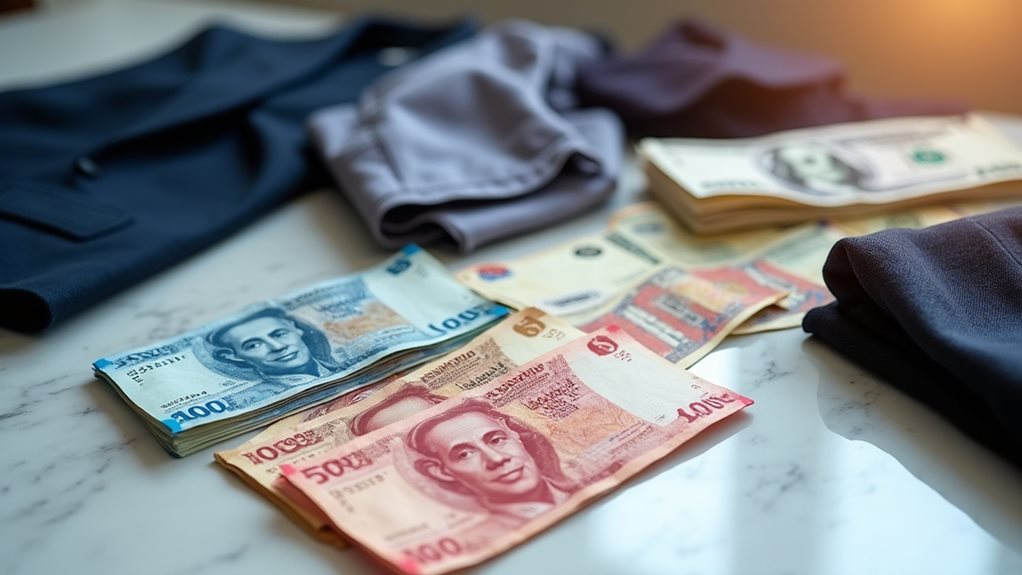
While researching dry cleaning costs for this article, I couldn’t help but feel a bit smug about our Philippine pricing until I started comparing notes with friends abroad – and wow, did that humble me quickly!
Here’s what I discovered about international comparisons:
- Price gaps are shocking – while we pay PHP 100-300 per item, New Yorkers drop USD 5-20 for similar services.
- Dry cleaning technology abroad often includes advanced eco-friendly processes we’re still catching up to.
- Metro Manila’s competitive pricing stems from lower labor costs compared to London or Sydney.
- Customer loyalty programs here focus heavily on value-for-money promotions, while international markets emphasize premium service experiences.
Though we might lack some technological bells and whistles, our affordability advantage makes quality garment care accessible to more Filipino families. In the United States, shirt dry cleaning typically ranges from $3-8 per piece, with budget chain establishments often charging less than high-end boutique cleaners in premium locations.
Popular Dry Cleaning Chains and Their Rate Structures
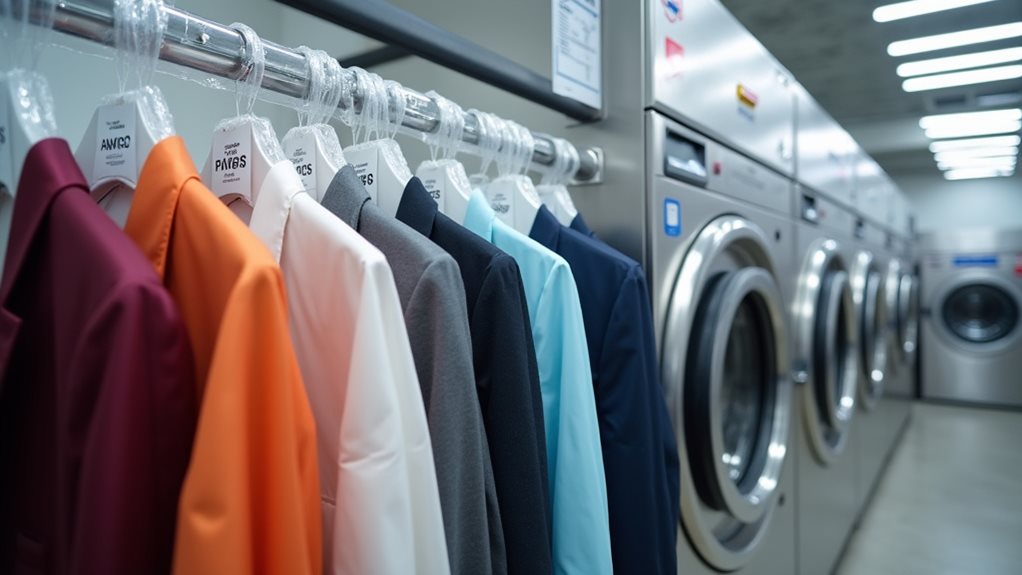
Three major dry cleaning chains dominate the Philippine market, and after testing each one with my favorite blazer (yes, I’m that person who brings the same item everywhere for consistency), I’ve learned their pricing strategies are as different as their customer service approaches.
Metropole charges PHP 200-300 for standard suits, while Lavada runs slightly higher at PHP 250-400, though their customer loyalty program offers 10% discounts after five visits.
These dry cleaning trends show chains competing on convenience rather than just price—Lavada’s free pickup service within Metro Manila honestly saved my sanity during busy weeks.
Both chains are adopting eco friendly practices too, using biodegradable solvents that cost more but appeal to environmentally conscious customers who’ll pay extra for sustainable cleaning methods.
Hidden Fees and Additional Service Charges

Those advertised prices you see at dry cleaning shops are just the starting point, and I learned this lesson the hard way when my “PHP 200 blazer cleaning” turned into a PHP 340 bill that left me staring at the receipt like it was written in ancient hieroglyphics.
Here’s what you need to watch for:
- Stain removal surcharges – That coffee spill you thought was “just part of cleaning” can add PHP 50-100.
- Express service premiums – Need it tomorrow? Expect 20-50% extra on top of base rates.
- Minimum weight charges – Your single shirt might cost the same as 2kg worth of clothes.
- Delivery fees – Convenience comes at a price, especially outside coverage zones.
Hidden charges awareness and service transparency importance matter for your wallet.
Always ask for complete pricing upfront – customer rights education starts with knowing what you’re actually paying for.
Money-Saving Tips for Regular Dry Cleaning Customers
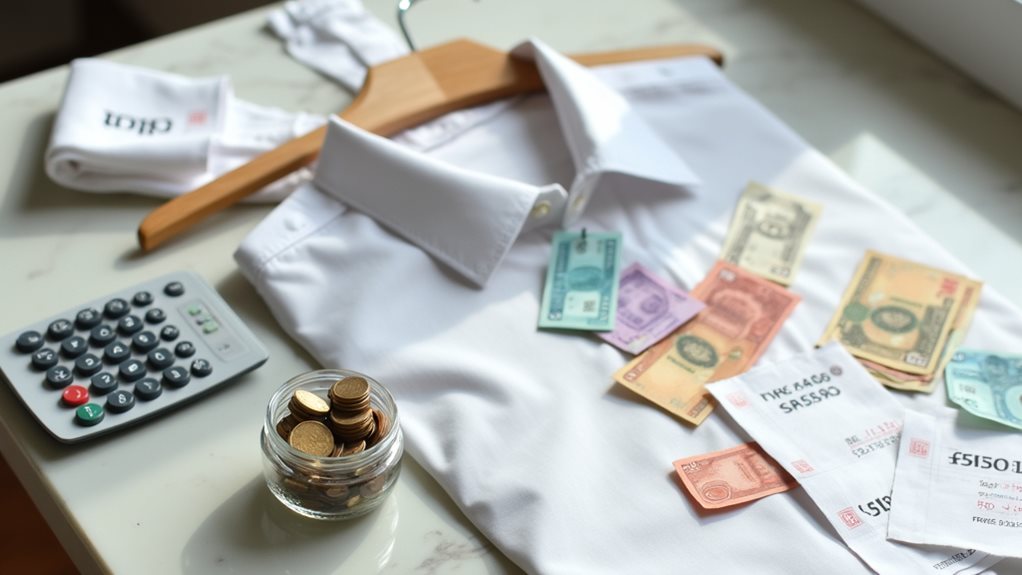
Since I started treating dry cleaning like a subscription service rather than random emergency trips, my monthly costs dropped by nearly 40%, and honestly, it felt like discovering a secret cheat code for adult life.
You’ll build customer loyalty by joining programs that reward service frequency, and trust me, those free cleanings add up faster than your coffee shop punch cards.
Bundle your items together because bulk discounts are real, and asking about eco friendly practices often reveals hidden promotions.
Schedule during weekdays when shops desperately need customers – I’ve scored 20% discounts just by avoiding weekend rushes.
Most importantly, maintain your clothes properly between visits; reducing frequency while maintaining quality saves serious money long-term.

